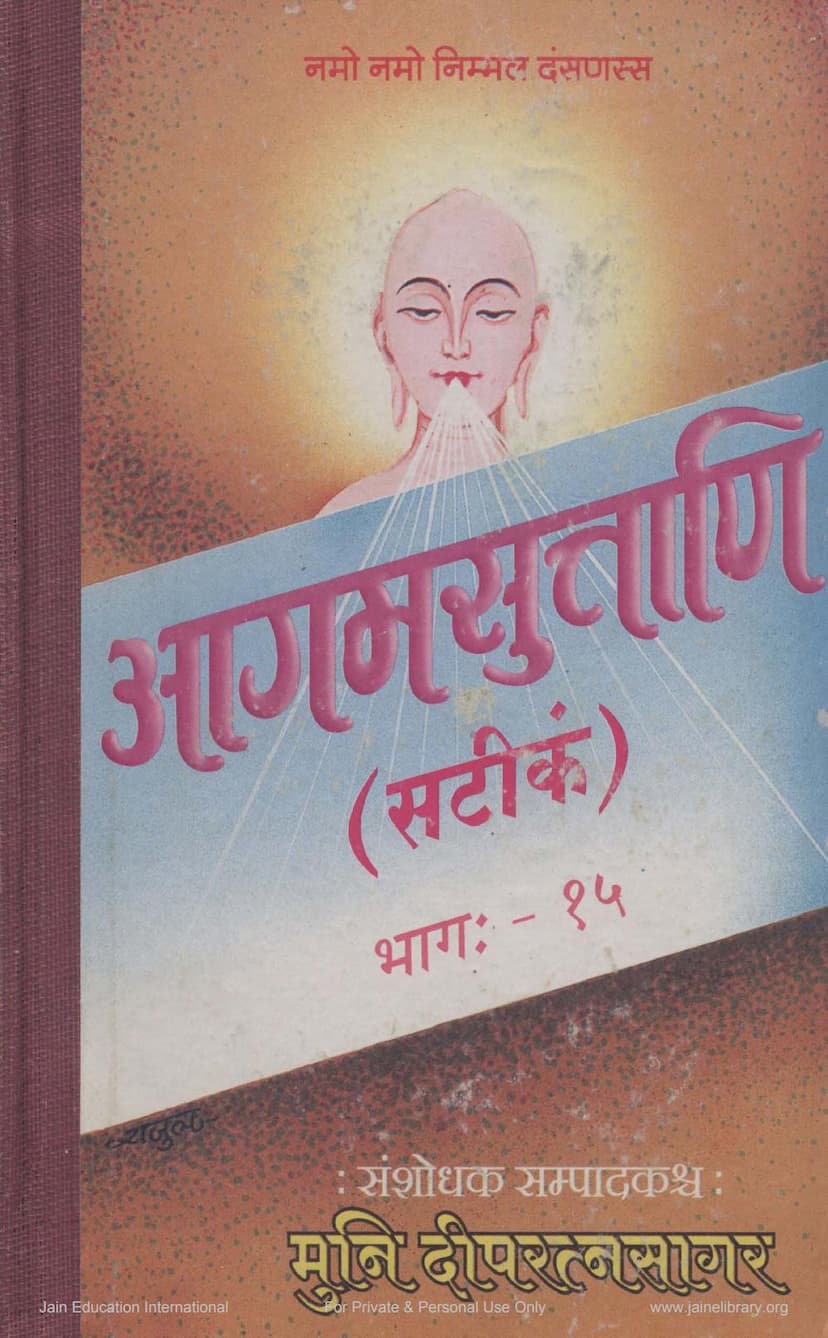Agam Suttani Satikam Part 15 Nishitha
Added to library: September 1, 2025

Summary
This is a comprehensive summary of the provided Jain text, focusing on the content related to Upaśama (Equanimity) and Paryuṣaṇa (Festivals of Atonement), as discussed in the context of the Nishitha Sutra, Part 15. The text delves into various rules and regulations, particularly those concerning the conduct of monks and nuns, with a strong emphasis on ethical behavior, discipline, and the avoidance of transgressions.
Here's a breakdown of the key themes and information present in the provided text:
Overall Structure and Context:
- Book Title: Agam Suttani Satikam Part 15 Nishitha (Implies a commentary on the Nishitha Sutra).
- Author/Editor: Dipratnasagar, Deepratnasagar (Editor: Muni Deepratnasagar).
- Publisher: Agam Shrut Prakashan.
- Content: The provided pages focus on the initial sections of the Nishitha Sutra (Upaśama, Part 15), detailing rules and consequences for various actions.
- Language: The text is primarily in Gujarati (written in Devanagari script) with significant use of Prakrit and Sanskrit terms common in Jain scriptures. The summary is in English.
Key Themes and Concepts:
-
Paryuṣaṇa Parva (Paryushana): While not explicitly detailed as a festival in these initial pages, the text's focus on the conduct of monks and nuns during a period of retreat or purification, as implied by the context of monastic discipline in Jainism, strongly suggests a connection to the principles of Paryuṣaṇa. This period emphasizes introspection, fasting, repentance, and adherence to strict vows.
-
Monastic Discipline (Vinaya): The core of the text revolves around the rules and regulations that govern the life of monks (bhikshus) and nuns (bhikshunis). This includes:
- Prohibited Actions (Nishedha): The text meticulously outlines actions that are forbidden for ascetics. These are often presented in the form of "Do not do X" or "If you do X, then Y is the consequence."
- Consequences of Transgression (Prayshchitta): For every forbidden action, a specific penance or consequence is prescribed, ranging from minor (laghu) to severe (guru) depending on the nature of the offense and the intent.
- Purity and Conduct: Emphasis is placed on maintaining purity in actions, speech, and thought, especially in relation to the body, possessions, and interactions with the outside world.
-
Types of Transgressions and Penalties: The text categorizes actions and their associated penalties, often based on the severity and context:
- Laghu (Minor), Guru (Major), Guru-Guru (Severe): Penalties are graded based on the gravity of the offense.
- Anushansika (Following the rules) vs. Ananushansika (Not following the rules): The text differentiates between intentional and unintentional or unavoidable transgressions, influencing the penance.
- Ananushansika (Unintentional): In cases of unintentional actions, especially due to ignorance or unavoidable circumstances, the penance might be lighter.
- Niyama (Rules) and Apavad (Exceptions): The text often discusses the general rules and then the exceptions or specific conditions under which certain actions might be permitted or have different consequences.
-
Specific Prohibitions and Their Contexts: The initial chapters (Upaśama 1-6) cover a wide range of forbidden acts, often related to:
- Movement and Travel: Rules about where and when monks can travel, especially in relation to inhabited areas, forests, and times of day/year.
- Possessions (Upadhi): Strict limitations on what monks can own or carry, including clothing, vessels, and tools. The text details how to handle or dispose of forbidden items.
- Food and Drink: Detailed rules about what food and drink are permissible, how they should be obtained, prepared, and consumed, especially concerning purity and avoiding harm to living beings.
- Interactions with the Outside World: Regulations on interacting with laypeople (grihasthas), non-Jains (ānavidharmikas), and even the natural environment (elements, plants, animals).
- Body Care and Hygiene: Rules related to bodily actions like cleaning, bathing, and handling the body, especially in relation to purity.
- Conduct in Monasteries (Vihara): Regulations for monks living in monasteries, including their interactions with each other and the environment within the monastery.
Key Terms and Concepts:
- Āgama Sūtrāṇi: Sacred Jain scriptures.
- Nishitha Sutra: A key scripture in Jainism dealing with monastic discipline and expiations (prayshchitta).
- Upashama: Mental tranquility, composure, a state of calmness and non-attachment.
- Nishitha: The core concept of the text, implying setting boundaries, discipline, and specific rules for monastic life.
- Kāyā: Body.
- Manas: Mind.
- Vacana: Speech.
- Karmas: Actions and their consequences, a central tenet of Jain philosophy.
- Samyama: Self-control, restraint.
- Ahimsa: Non-violence, a foundational principle.
- Pratikramana/Paryuṣaṇa: Rituals of repentance and confession.
- Apavad: Exception.
- Prāyaścitta: Penance or expiation for transgressions.
- Sadharmik: Fellow Jains, members of the same religious community.
- Agamya/Anagamya: Permissible/Impermissible.
- Dravya: Substance/Matter.
- Bhava: State/Condition/Mental state.
- Kāla: Time.
- Kṣetra: Space/Place.
In essence, this section of the Nishitha Sutra serves as a rigorous code of conduct for Jain ascetics, emphasizing meticulous attention to detail in their daily lives to uphold spiritual purity, minimize harm to all living beings, and progress on the path to liberation. The detailed classification of actions and their associated penalties highlights the Jain emphasis on ethical responsibility and the consequences of even seemingly minor deviations from the prescribed path.